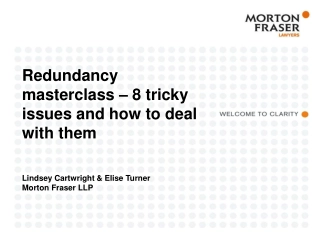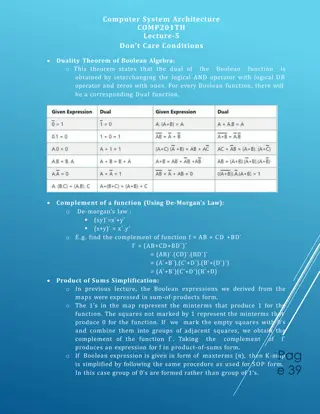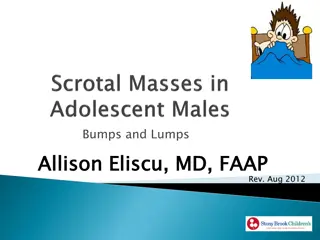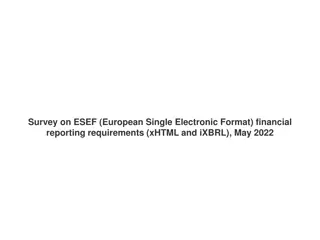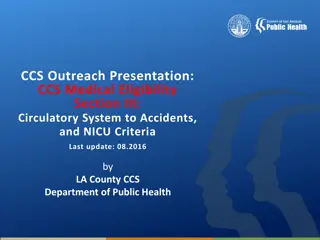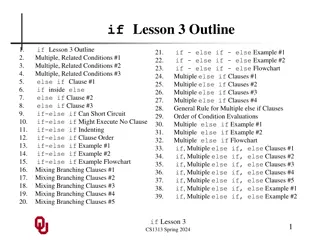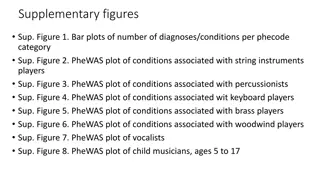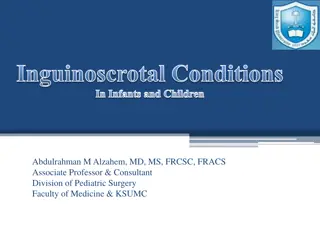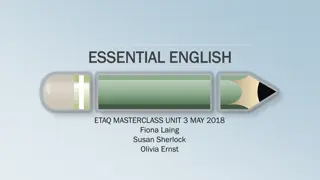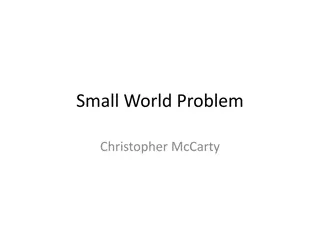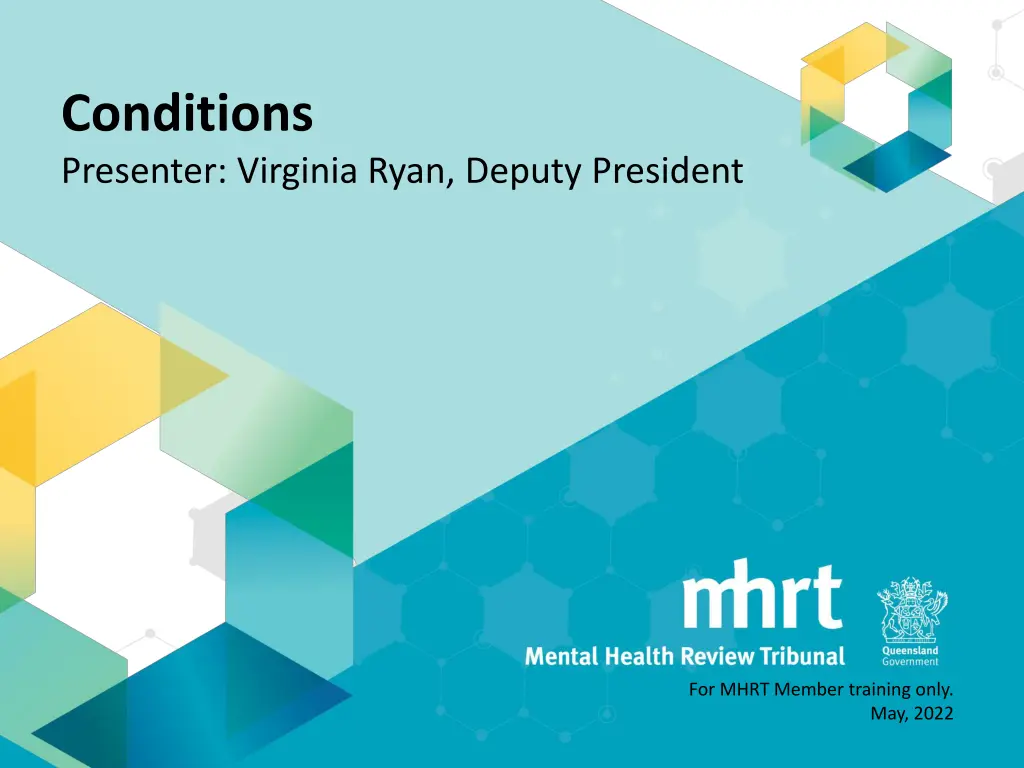
Understanding Conditions in Mental Health - Examples and Considerations
Learn about conditions imposed by Mental Health Review Tribunals and other authorities, including what constitutes a good condition and human rights considerations. Explore specific examples and the purpose of conditions in mental health care. Understand the differences between conditions and Limited Community Treatment (LCT).
Download Presentation

Please find below an Image/Link to download the presentation.
The content on the website is provided AS IS for your information and personal use only. It may not be sold, licensed, or shared on other websites without obtaining consent from the author. If you encounter any issues during the download, it is possible that the publisher has removed the file from their server.
You are allowed to download the files provided on this website for personal or commercial use, subject to the condition that they are used lawfully. All files are the property of their respective owners.
The content on the website is provided AS IS for your information and personal use only. It may not be sold, licensed, or shared on other websites without obtaining consent from the author.
E N D
Presentation Transcript
Conditions Presenter: Virginia Ryan, Deputy President For MHRT Member training only. May, 2022
Topics What are conditions? What makes a good condition? Human rights considerations Examples 2
What are conditions? The MHRT has the authority to change, remove or impose a condition on a TA, FO or TSO (ss 426, 447, 478). Those sections appear in the subdivisions that apply if, on review of the relevant authority/order, the MHRT confirms the authority/order. Other sources of conditions: Conditions may also be imposed on an FO or TSO by the MHC. Authorised doctors may amend an authority/order, to impose or change a condition so long as the amendment does not change, and is not contrary to, a condition decided by the MHC/MHRT. 3
Specific examples in the MHA2016 Condition is not defined in the MHA2016 except to say that it does not include a condition requiring a person to wear a tracking device (Schedule 3) EXCEPT when the MHC or MHRT makes an FO or confirms an FO. The MHA2016 specifically: prohibits the MHC and MHRT from imposing a condition that requires a person to take a particular medication or a particular dose of medication. in relation to FOs/TSOs, authorises the MHC and MHRT to impose a non-contact condition about a stated person, including, for example, a victim of the relevant unlawful act. 4
Purpose of conditions The wording of the relevant sections specifies conditions are imposed on the relevant authority/order and authorises changes to conditions to which the [authority/order] is subject . The conditions sit on the authority/order so the person is only subject to those conditions while the authority/order is in place. From the examples of conditions that can and cannot be made, conditions can be said to direct the subject person to positively do something or prohibit the person from doing something. An authority/order is a lawful authority to provide treatment and care (or just care) to the subject person and, where inpatient category, to detain the person. The person s detainment, treatment and care is, therefore, conditional on any conditions. 5
Conditions vs LCT Limited community treatment (LCT) is defined to mean the treatment and care of a person in the community, including in the grounds and buildings (other than an inpatient unit) of an (AMHS), for a period of not more than 7 consecutive days, that is authorised under the Act (Schedule 3). Section 16 provides that the purpose of (LCT) is to support a patient s recovery by transitioning the patient to living in the community with appropriate treatment and care. The extent and nature of LCT is therefore a different concept to that of conditions. The MHC/MHRT can order or authorise LCT. Authorised doctors can determine the exact nature and extent of LCT so long as their decisions are not contrary to what has been set by the MHC/MHRT. 6
Conditions vs Category The conditions are made on the authority/order and therefore apply at all times regardless of category. When inpatient, the conditions are likely to be of less relevance that is, the person is not likely to have the ability to move about the area freely, have access to alcohol or drugs, be able to obtain weapons or drive a motor vehicle. The conditions would be applicable during at period of LCT. 7
Is there a test for conditions? Conditions are most relevant for FOs. For FOs, the concept of unacceptable risk is relevant to the tests for considering: the category; and whether to approve LCT for an inpatient. That concept is not used in the provisions dealing with the MHRT making conditions. Those sections of the Act simply state that the MHRT may impose a condition. Unacceptable risk is therefore used when making decisions about whether to expand/increase/extend the access a person has to the community. 8
Is there a test for conditions cont. Contrast the FO position with that of a TSO when considering the test for category. To approve any extension to access to the community, the test is unacceptable risk. The default category for TSOs is community; it is any restriction on full community access that must be approved for a TSO. If anything which impacts on full access to the community constitutes a restriction, conditions are likely to be a restriction on community access. Since unacceptable risk is not the appropriate test for restricting community access, it is not the appropriate test for deciding conditions. 9
How to decide if a condition is appropriate The question is more about whether a condition which restricts some aspects of community living is required in order to be able to expand time in the community. In practice, say you have confirmed the FO in the following scenario: Is there not an unacceptable risk to making the category community? No, that is, there is an unacceptable risk. We cannot make the category community because the risk of the impact of substance use by the person are unacceptable. Can I use the authority to make conditions to limit the parameters of the community access so that the risk is reduced to an acceptable level? Yes, we can add a condition requiring abstinence and testing for substance use. The decision to impose conditions must form part of the panel s human rights considerations. 10
FO vs TSO Do they need different conditions? As we noted above, there is no test for conditions. A TSO should be community category unless one or more of the following cannot be reasonably met if community: person s treatment and care needs. safety and welfare of the person. safety of others. Conditions can be used to satisfy the Tribunal the above can be met when the person is in the community. For example: the Tribunal may consider that the person s treatment and care needs cannot be met in the community unless a condition is imposed that the person must attend at appointments scheduled by their authorised doctor. the Tribunal may consider that the person being in the community represents an unreasonable risk to the safety of others unless a condition is imposed that prohibits the person accessing illegal drugs and requires them to submit to UDSs. 11
AppealtoMHC0019 No difference in conditions between FO and TSO In this matter, the MHRT revoked the FO and made a TSO and carried over the imposition of the same conditions to the TSO. The patient appealed the matter and objected to the inclusion of the same conditions on the TSO. The MHRT s SOR explained that they decided the conditions should remain in place on the basis that the patient was transitioning to less management/monitoring by the treating team. The OCP s submissions noted the differences between an FO and TSO exist even when the conditions imposed on the TSO are continued from the FO. Therefore, a TSO with the same conditions as an FO is still less restrictive. The Court found that it was appropriate for the patient to remain on a TSO and kept the same conditions. The patient s appeal was dismissed. 12
Purpose of conditions On the basis of the reasoning we have looked at: conditions are clearly restrictive on the one hand they may prohibit a person from going to a certain location, doing a certain thing or engaging with a particular person. conditions may also be enabling without the conditions in place, the risk would remain unacceptable and the person may not be permitted as much LCT. Conditions could be seen as useful for risk mitigation purposes. 13
What makes good conditions? Clarity Conditions need to be carefully drafted and clear. A reader should be able to understand exactly what is required and when. If two interpretations are possible, how is the subject person going to know which one is the correct one? Consider your audience who needs to understand the condition the subject person, support workers, carers, treating team members. Consider that there are some commonly understood terms amongst AMHSs (e.g. supervised). 14
What makes good conditions cont. Effective in its purpose Why are you imposing the condition? What is the outcome you are looking to achieve? Will the condition, reading it the way it is drafted, achieve its intended purpose? E.g. if the problem is alcohol consumption and the panel want to stop the person drinking alcohol, will prohibiting the person from purchasing alcohol achieve that purpose? Not necessarily someone else could purchase the alcohol. Will it put an unnecessary burden on others? 15
What makes good conditions cont. Condition on the authority/order Is it something with which the person can actually comply? If the condition relies on action by someone other than the person, what are the consequences if the other person does not take that action? Is the person the subject of the order in breach? Monitoring Will it be possible for the treating team, or in fact, the person themselves to monitor whether the person is compliant with the condition? If not, is there value in imposing the condition? There may be circumstances where it is it lets the patient know what is and is not appropriate. 16
What makes a bad condition? The opposite of the above! The condition is: unclear, it could mean different things to different people. not effective in achieving its purpose. aimed at someone other than the subject person. not able to be effectively monitored or measured. inconsistent with something else required of the person. 17
Having regard to language in conditions The specific language used in conditions is important. We are used to seeing conditions worded in a similar way and can miss gaps or situations where they do not apply. Where the FDS is the service responsible for a person s FO (Disability), consider the use of senior practitioner rather than authorised doctor or treating psychiatrist . Where a person only has an intellectual disability (whether they be on an FO (Disability) or FO (mental health) see In the matter of BAC), conditions should not refer to treatment and care , rather just care . 18
Human rights considerations All of the MHRT s decisions must comply with the Human Rights Act 2019 (HRA). Often the same considerations will be taken into account to decide if any limitation of human rights caused by the decision is reasonably justifiable (s13 HRA) as those for a decision to confirm an authority/order or to decide category. Can be some quite specific/nuanced human rights considerations required for conditions depending on the individual circumstances of the matter. Remember each condition needs to be considered separately there is no standard bundle of conditions. Do you have evidence to support your decisions in relation to the conditions? 19
AG for the State of Qld v GLH A case heard by the MHC, on appeal from the MHRT, in 2021. A good explanation of human rights decision-making in the context of the MHA2016. Takeaways from that case: In considering whether to impose a condition, it is necessary to consider compatibility with human rights. Specifically, in relation to conditions on an FO, it is important to consider whether the safety of the community is exposed to unacceptable risk. The requirement that any limit be the least restrictive of the human right and limited to only what is necessary to address an unacceptable risk to safety has been developed to be protective of the underlying rights to the greatest extent possible. 20
AG for the State of Qld v GLH cont. Takeaways from this case continued: The Court accepted the QHRC submission that Victorian cases establish that the question is not whether there is no risk because there is always some risk but whether the risk is unacceptable. There must be sufficient likelihood of the occurrence of the risk in combination with the magnitude of harm if the risk eventuates and any other relevant circumstances which make the risk unacceptable. The imposition of conditions which address the risk must be proportionate or no more onerous in the extent of their limitation upon human rights than required. 21
AG for the State of Qld v GLH cont. This particular case related to a condition that the patient not have unsupervised access to children. The Court found that there was not an unacceptable risk for the patient having unsupervised access to children. The factors that the weighed up in reaching this conclusion: The risk is a more general and the risk to children was no greater than the risk to others. The treating psychiatrist s evidence that they did not consider it to be an unacceptable risk. The patient had not acted on his odd beliefs for a long time, he had not engaged in violence for a number of years, the circumstances surrounding the index offence had not reoccurred and he had no recent contact with child protection services. His access to children in his family/community is a protective factor because he has a view that he has to protect them. The patient s family agree with this point. Imposing the condition was more likely to do harm to the patient as an Indigenous man who took his role as an uncle seriously. 22
Documenting proper consideration of human rights We covered this in the Member Deliberations Masterclass earlier in May 2022. Case law suggests proper consideration requires you: proceed in a practical and common-sense manner. identify all human rights that your decision may affect. turn your mind to the impact of the decision on human rights. consider countervailing interests and obligations. consider compatibility with human rights (the proportionality test). Evidence of these steps is required. This evidence would come from what is documented in the SOR which is taken from the MD. 23
What if a patient breaches conditions? The MHRT does not have a role in enforcing its orders. The purpose of conditions is not punitive. A breach of conditions may be taken into account by the MHRT in its future decision-making. May be indicative of risk if a condition has been imposed to mitigate risk and there is non-compliance with the condition, is the risk being mitigated? Does the breach sufficiently increase risk such that a different decision must be made at what stage does the risk become unacceptable? AppealtoMHC024/GLH tells us that a breach of conditions (using illegal drugs) did not automatically represent an unacceptable risk. It is necessary to weigh up all the relevant risk factors and protective factors and determine if there is an unacceptable risk. 24
Example Risk to children The Tribunal has found that the patient represents an unacceptable risk to children if alone with a child in the community. The Tribunal therefore wants to make the category of the patient s order community and include a condition to mitigate this risk. What do members think about this condition: The patient must not be alone with children. 25
Example Risk to children Other options: That the patient not initiate contact directly or indirectly with any person under eighteen (18) years of age. That in the event the patient is going somewhere he may come into contact with a minor/s, he is to be supervised at all times by a responsible adult who is approved by the treating psychiatrist. That in the event the patient finds himself in the immediate presence of a person under eighteen (18) years, the patient is to immediately remove himself from the presence of the person under eighteen (18) years of age. 26
Example Geographical restrictions The index offence related to an unprovoked physical assault on the victim. The Tribunal had regard to a victim impact statement in which the victim describes feeling very threatened by the patient and fears leaving their house in case they run into them. There is evidence that the patient does not have insight into the impact of the offence on the victim and would have no problem with seeing the victim in the community. At the first review of the FO, the Tribunal wants to put a condition on the FO that the patient not go to the suburb the victim lives in. What do members think about this condition: The patient must not travel to Albion. 27
Example - Weapons The index offence involved a weapon a knife. The patient continues to look to carry a knife when he leaves his house. The Tribunal wants to approve community category and prohibit the patient having or carrying knives. That the patient not possess any weapons. Considerations: Is the word possess clear enough for the patient? Does it prevent having knives in the house? Does it prevent the patient carrying one on him when he leaves the house? What is meant by weapons ? Would this include a hunting knife? Would it include a butter knife? Would you keep the word weapons or would you restrict it to knives? What if the patient obtained a job in hospitality and this meant he would from time to time hold a knife (e.g. when clearing tables in the restaurant)? 28

